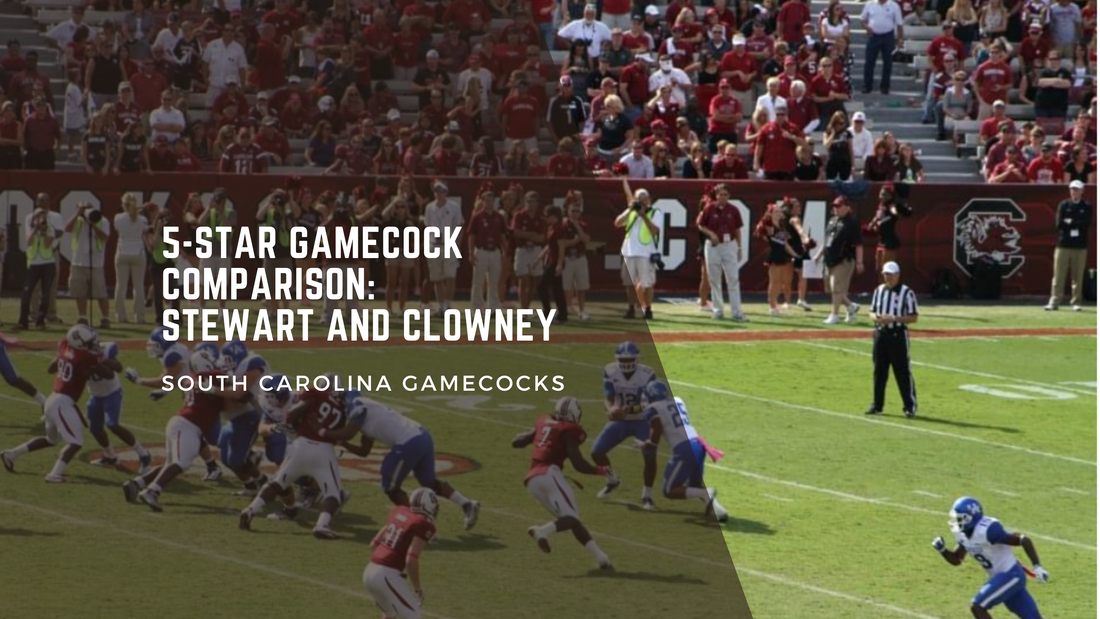
5-Star Gamecock Comparison: Dylan Stewart and Jadeveon Clowney
Share
With current fan discussions surrounding what freshman five-star Dylan Stewart’s impact will be on the South Carolina defense in 2024, I thought back to fan expectations on another five-star defensive end signing for the Gamecocks in 2011: Jadeveon Clowney.
I played with Clowney on that 2011 squad and even lined up next to him in games as I played the “Spur” position (Nickel) in Coach Ellis Johnson’s defense. Even as a true freshman, you could tell Clowney was just different than most players - even at the SEC level.
Based on Stewart’s tape and what coaches are saying in preseason, there are plenty of signals for why he will also live up to the hype. However, he is a much different defensive end than Clowney in terms of athleticism and style of play.
In this breakdown, we’ll take a look at some key similarities and differences, and how I expect that to translate for Stewart in the Garnet & Black.
“Choose Your Weapon”
Every great defensive end has their main weapon (move or athletic-based strength) they use to strike fear in offensive linemen. It may be a technical move like Dwight Freeney’s spin or an athletic-based move like James Harrison’s bull rush.
For Clowney, his best weapon was and is his first step. At the snap of the ball, Clowney can be at the outside hip of the tackle in the blink of an eye causing disruption for the entire play. This is why Clowney has been one of the most double-teamed edge players in the NFL. See the below picture from our game vs Kentucky in 2011.

Right as the quarterback gets the ball, Clowney is already in the backfield forcing him to hand the ball off or pay the consequences.
For Stewart, his best weapon is his flexibility and bend around the edge. This may seem less important than a quick first step or a bull rush but the bend is really the secret sauce to many of the best edge players in college and the NFL. Stewart can get low at the snap, avoid offensive tackle’s grasps, and accelerate while collapsing the quarterback’s pocket or runner’s lane. The ability to play with low pad level while maintaining speed and power is a rare gift for someone Stewart’s size.

Image via The State
Style Points
Even though Clowney and Stewart both entered college at the same position, at a similar size, and as blue chip recruits, they both have very different playing styles.
Clowney’s style is best defined as explosive and aggressive. His first step is his best weapon and his lower-body strength and length enable him to power through or hold up blockers at the point of attack. This makes Clowney a more balanced player than people realize as he can hold his ground against the run or when facing double-teams in the passing game. Clowney can play edge standing up but he’s best with his hand in the ground where he can really explode out of his stance and attack, which keeps offensive linemen as far back in their stance as they’re allowed to get.
Conversely, I see Stewart being able to stand-up as much as or even more than being in the three-point stance. Stewart’s strength is his bend so he doesn’t need to be in a three-point stance to get low and win leverage against offensive linemen. One thing on his tape that I really like is his ability to stay square and use his hands, which enables his eyes to stay focused on the ball. I would characterize his style of play as “read, react, attack” and given his elite athleticism and high IQ, Stewart can do it all within a split second of the snap of the ball. For a current NFL comparison, Kayvon Thibadeaux of the New York Giants has a very similar athletic build and style of play.
Freshman Year Playing Time
Back in 2011, Clowney came into a loaded defensive end room which included starters Melvin Ingram and Devin Taylor, both of whom earned All-SEC honors. To get Clowney on the field more than just a rotational player in year one, Coaches Ellis Johnson and Brad Lawing installed the “Rabbit” package which slid Ingram down to defensive tackle and brought Clowney in as the edge player. This was done on first down to try to get the offense to counter into a run-first play but primarily in passing-first situations where the quarterback would be a sitting duck, and it worked like a charm for us as we had one of the nation’s best overall defenses.
Similar to Clowney, Dylan Stewart will also likely ramp-on to the SEC level as a passing down specialist but for different reasons than Clowney.. And likely not for very long.
Stewart comes into a defensive end room where he is arguably the best player from day one. If South Carolina ran the 4-2-5 defense as its base consistently, I’d sharpie him in as the weak side end starter. However, the Gamecocks run a multiple scheme where they also use the 3-3-5, which only features one defensive end. The biggest question mark I have is: how creative are the coaches going to be to get Stewart onto the field? They could use him as a passing down specialist early until he gets acclimated or as a rotational player behind both current edge starters Kyle Kennard and Gilber Edmond. If Stewart can master playing multiple edge spots in each defensive front base, expect him to be a starter by the middle of the season.
Projecting the Stats
In 2011, Clowney finished his freshman campaign with 36 tackles, including 12 tackles-for-loss and 8 sacks to go along with 5 forced fumbles. Clowney was productive but even more so disruptive. Clowney earned Freshman All-American honors to go along with being awarded as the SEC Freshman of the Year.
In 2024, I’d expect Stewart to finish with a slightly higher tackle total, while being lower in tackles-for-loss and sacks, just based on the difference in playing style and usage. I would bet on Stewart earning Freshman All-American honors and think he could be in consideration for SEC Freshman of the Year, depending on how good the Gamecocks are as a team.
Read About Gamecocks & the Author, Matt O'Brien HERE